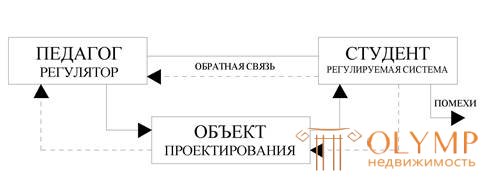
Based on the didactic principle, the unity of the student’s learning activities and the teacher’s learning activities, the intensification of teacher – student interaction and the intensification of the educational process take place at the level of architectural design. The complex creative process of architectural design is due to the interaction of the three components of teaching: the teacher “P”, the student “C” and the project model of the object “O” being transformed under their influence. At the initial stage of training, the teacher and the student are in a “master” and “slave” relationship in the course of the administrative process, which corresponds to the small creative preparation of students. The teacher actively influences the projected model of the object and thus the student, but the communication is imperfect - the feedbacks are weak (Diagram 2, above). The disadvantages of such a structure of training are most pronounced in senior courses and need to be overcome.


Scheme 2.
Currently, the teacher in the chain - the project model - the student needs a transition to a system of interaction - partnership, towards an orientation towards joint creative activities based on strengthening feedback. Purposeful interaction between the student and the student through the project is carried out in the act of communication. The teacher and the student are active participants in this interacting system - the exchange of information through the design decision involves the establishment of mutual contacts (Scheme 2, below).
The feedback mechanism between the student and the teacher ensures that the necessary operations are carried out - expedient behavior of the student with a minimum of “interference” - errors in the student's understanding of the teacher's advice. Mutual understanding between partners is based on the use of professional tools, languages, coded messages, understandable to both sides of the communication learning process. The teacher-architect, sending information to the student, takes into account the needs and interests of the student based on aesthetic, psychological and value attitudes. The student responds to the information of the teacher with his own informational reaction, which confirms the existence of an act of communication between them. At the same time, the recommendations of the teacher carry in themselves an element of persuasive influence, which is aimed at teaching the design procedure, solving the problems arising in the process of modeling, and developing thinking skills.
The system of cooperation and partnership is aimed at mastering the profession and stimulates the independent search, creative and cognitive activity of the student who is responsible for making the decision. From the activity of the impact of the teacher and the student on the object of activity depends on the effectiveness of the design. At all levels of training for students, an atmosphere of benevolent support and close attention of teachers to their professional development should be created.
The communicative process integrates cognition, communication and activity. However, under the conditions of the AP, not only is the productive exchange of information, but also a transformation, a creative interpretation of information aimed at aesthetically shaping the design model, the functional meaning of the object being created, its “structural theme”, the artistic image and through them the ideological content of the work are perceived. The teacher remains a professional critical assessment of the created project model. Joint active cooperation between the student and the student constitutes a multilateral, mutually enriching process.
Educational architectural design is organized by the teacher-architect in the direction of creative self-improvement of students and their search for new knowledge.
The teaching of architectural design consists in consulting and guiding the creative work of students, in understanding and processing the program material, and in conveying information to the student in various ways. The main ones are voice messages, a link to an analogue, sketches in the margins of a drawing, diagrams, or direct correction of a student’s sketch. The activity of the teacher in the process of educational design is to reduce the incidents, uncertainty and disorder contained in the project sketches of students.
The specificity of teaching architecture lies in the predominance of the student's independent search activity, which ensures the development of abilities and mastery of the creative method of design modeling. The creative and cognitive activity of the student is united in creative activity, his value orientations are formed. In the process of architectural design, the student's own searches are adjusted by the architect-teacher, which increases the productivity of creative activity. The teacher's advice aimed at the development of the project intent opens up the way for the creative development of the program to the student. The student translates the received information into a design solution.
The message of the teacher can relate to the entire group of students, then the student, in relation to his decision, must convert the information and draw the appropriate conclusion from it. The teacher examines the training task, the situation and develops with the students the target installation. Organizing the work in the group, the teacher sets the general tasks for the students in accordance with the stages of the creative process, reveals the content and controversial nature of the design, encourages students to creative activities. The teacher uses different methods at different stages of learning, demonstrates his
professional skills, foresees the ways of possible development of the project design, checks, controls the work of the student and evaluates his project proposals.
Что бы оставить комментарий войдите
Комментарии (0)